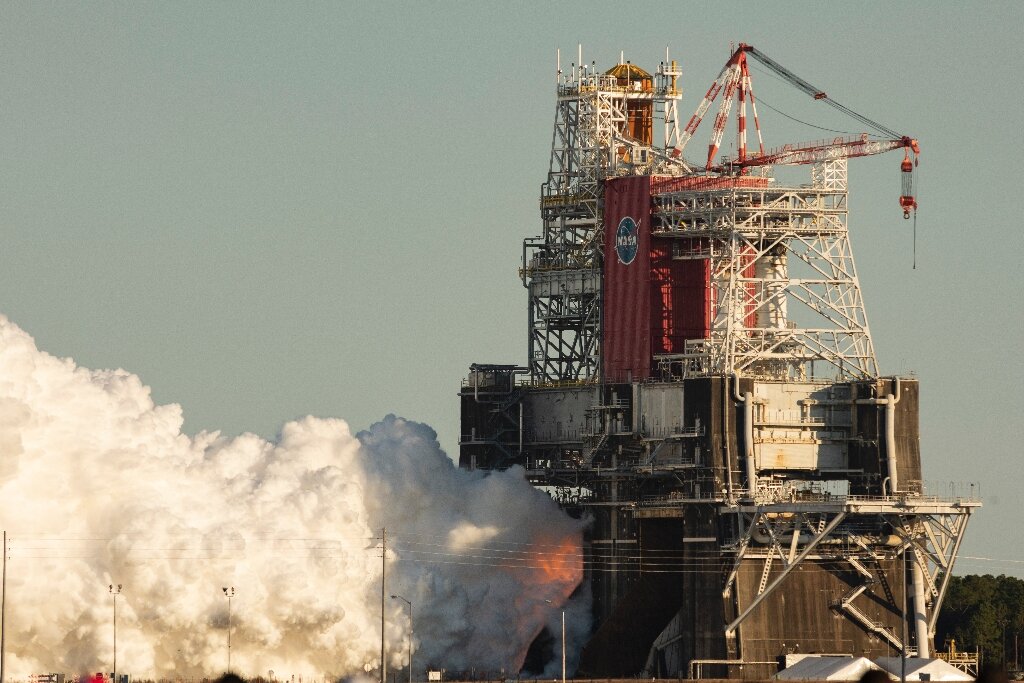#NASA testing giant rocket for next Moon mission

“#NASA testing giant rocket for next Moon mission”

NASA was preparing for a key static test of its troubled Space Launch System (SLS) rocket on Thursday as the agency prepares to return to the Moon.
The second “hot fire” test will see all four of the rocket’s RS-25 engines fire simultaneously and achieve a maximum of 1.6 million pounds of thrust (7.1 million newtons).
A two-hour window for the test began at 3:00 pm Eastern time (1900 GMT). At around 4:00pm, NASA said the text was expected within 45 minutes.
It will be the second such test involving the 212-foot (65-meter) high core stage at the Stennis Space Center near Bay St. Louis, Mississippi, after the first was cut short in January.
NASA released a statement following that test that said “no major repairs” were required after the engines were cut just one minute into the eight-minute run, but did not detail what went wrong.
Thursday’s test should also last eight minutes, and is intended to provide data that will help minimize risk on the lunar missions.
The rocket’s tanks were filled with 700,000 gallons (2.6 million liters) of cryogenic propellant, which will fire the engines, which were repurposed from Space Shuttle missions, including the very last in 2011.
If all goes well, it will take about a month to refurbish the core stage, then it will be transported by barge to the Kennedy Space Center in Florida.
There, it will be assembled with the other parts of the SLS rocket and the Orion crew capsule, which are being prepared for the Artemis I launch later this year—an uncrewed mission.
The SLS program has been beset by delays and cost overruns, and was initially due to be operational in 2016.
Ars Technica reported this week NASA was conducting an internal review of its affordability.
NASA said last August the baseline development cost was $9.1 billion and the initial ground systems capability required $2.4 billion.
It has also been criticized as a “jobs program” for NASA’s Marshall Space Flight Center in Alabama, as well as for its key contractors Boeing, Aerojet Rocketdyne and Northrop Grumman.
While SLS is far more powerful than SpaceX’s Falcon Heavy rocket used to put satellites in orbit and take crews to the ISS, Elon Musk’s company is also working on a prototype rocket called Starship that will be capable of deep space exploration.
Starship’s last three test flights have ended in stunning explosions, but analysts believe the mishaps could paradoxically be accelerating the spaceship’s development, eventually making it a viable alternative to SLS.
NASA’s SLS moon rocket readies for next pit stop on way to Kennedy Space Center
© 2021 AFP
Citation:
NASA testing giant rocket for next Moon mission (2021, March 18)
retrieved 19 March 2021
from https://phys.org/news/2021-03-nasa-giant-rocket-moon-mission.html
This document is subject to copyright. Apart from any fair dealing for the purpose of private study or research, no
part may be reproduced without the written permission. The content is provided for information purposes only.
If you liked the article, do not forget to share it with your friends. Follow us on Google News too, click on the star and choose us from your favorites.
For forums sites go to Forum.BuradaBiliyorum.Com
If you want to read more Like this articles, you can visit our Science category.




